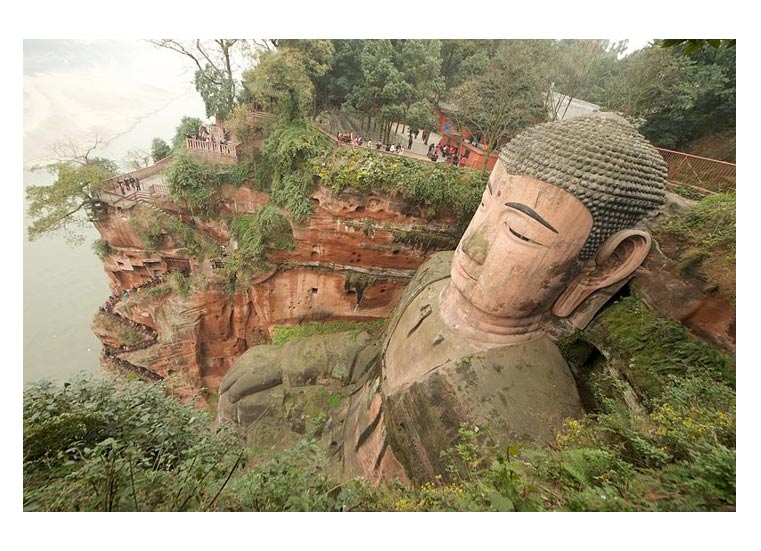The Leshan Giant Buddha Statue

Leshan Giant Buddha Facts
Located in Leshan City, Sichuan Province, Leshan Giant Buddha was constructed during the 713 and 803 Ad time frame, rising 71 meters into the sky.
Leshan Giant Buddha in fact is a statue representing a Bodhisattva monk that's sitting. Leshan Giant Buddha lies more precisely to the eastern part of Leshan City, at the convergence of three rivers, respectively Min River, Dadu River, and Qingyi River. By standing so high and taking on a bigger-than-than-life status, the statue became the most famous tourist attraction in Leshan. In December of the year 1996, the entire area where the Leshan Giant Buddha sits was declared a UNESCO World Heritage-protected site. Started in 713 during the Tang Dynasty, completing by 803, Leshan Giant Buddha consumed nearly one whole century for people to carve. Throughout these years, workers in the thousands had poured both their tireless endeavors and wisdom into the on-going project. As the world's largest carved stone Buddha, Leshan Giant Buddha is now featured in story, song, and poetry.
The Size of Leshan Giant Buddha
By facing the river incidentally, the statue has a symmetrical outline and appearances exquisitely identified in its solemn serenity. Towering 71 meters tall, fingers 8.3-meter-long, and instep 9-meter-wide, Leshan Giant Buddha is large so that 100 people could sit on it. Moreover, the shoulder 24-meter-wide is big enough to accommodate an entire basketball playground.
Architectural Features about Leshan Giant Buddha
The allure of the statue exists not only because of its sheer physical dimensions but also on account of its architectural beauty. For example, there are literally 1,021 buns in its coiled hair, which have been carefully lodged in the head. And the overall effect of the painstaking labor is so stunning that the magnitude of buns appears inherent to the whole.
Another architectural aspect worth noting is the sewerage system, which comprises concealed channels and gutters, distributed on the arms and head, back of the ears, and even in the clothes. This drainage system, which removes rainwater and thus maintains the inner section dry, fulfills a critical role in protecting the statue. Each ear, 7 meters long, is built of wood, plus mud adorns on the surface; it was no simple job to repair these for craftsmen from another much earlier era.
History of Leshan Giant Buddha
A monk known as Hai Tong, began the project. But his main worry was for the greater safety of the hardworking people who habitually earned their honest living near the three rivers' confluence. Tumultuous waters guaranteed the accidents of boats were many and the uneducated people attributed natural disasters to a water spirit identity. As a solution, Hai Tong made up his mind to start carving a statue next to the river assuming that the now Leshan Giant Buddha would somehow quell the water spirit. Moreover, all the stones falling throughout the carving process would decrease the water's overall force there. With 20 years' worth of begging alms collected, he accumulated eventually enough funds for the project. When a few local governmental officials hinted their intentions to take his money, Hai Tong responded that they can remove his eyeballs but absolutely not all the money gathered for the statue. When Hai Tong did the unthinkable, digging out his own eyeball, the frightened officials fled. The project reached the point of being half done by the time Hai Tong died, and then two of his loyal disciples went on with the work. Following a grand total of ninety years' worth of labor, the project inevitably came to a completion.
Holding such a lengthy history and international renown, the Buddha's renovation has gotten much attention not only at home but also abroad. The Buddha was almost destroyed via the combined erosion of rain and wind prior to 1963, in which the Chinese government started major repairs. Currently, UNESCO experts have taken charge of the maintenance work.
Ways to Go from Chengdu to Visit Leshan Giant Buddha
Train: take Chengdu-Leshan-Emeishan Intercity High-Speed Train from Chengdu
Bus: it's 100 miles from Chengdu City to reach Leshan City if traveling by the expressway. Tourists could take a bus from Chengdu Xinnanmen Bus Station to reach Leshan Xiaoba Bus station, and finally switch to city bus 13 to get to this site.
Ship: numerous ferries travel to the Giant Buddha site daily. For example, Ferries to Chongqing, Yibin and Luzhou are available often at the city's port.
Air: Chengdu Shuangliu International Airport is approximately 93 miles away from Leshan by freeway. At the airport, you could board a train or a bus to reach Leshan downtown; next, switch to a city bus for arriving here.
Most Famous Must-See Attractions in China
